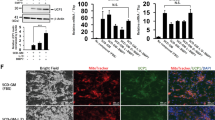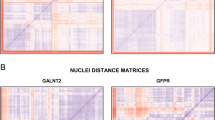Abstract
Background:
Rodent brown adipose tissue (BAT) is considered the main effector of adaptative thermogenesis as it contains a unique mitochondrial uncoupling protein, termed as uncoupling protein-1 (UCP1). The emergence of ectopic brown adipocytes in the white adipose tissue (WAT), called recruitment, might play an important role in the prevention of obesity. The recruitment phenomenon has until now been investigated mostly in vivo.
Objectives:
This study is an attempt to mimic in vitro the recruitment phenomenon. It consisted in culturing the stroma vascular fractions of mouse BAT and WAT in a brown adipocyte differentiation medium. The multilocular cells obtained, referred to as BATB and WATB adipocytes, respectively, were compared.
Results:
The BATB and WATB adipocytes were morphologically different. The expressions of UCP1, peroxisome proliferator-activated receptor-γ coactivator-1α (PGC-1α), leptin and resistin mRNAs were low in WATB adipocytes as compared with those in BATB adipocytes. The expressions of UCP1 and PGC-1α proteins were, however, much higher in WATB adipocytes, amounting 51% and 36% of those in BATB adipocytes. The patterns of expression of UCP1, PGC-1α and leptin in the BATB and in WATB adipocytes were different with a higher relative expression of PGC-1α in the latter. Rosiglitazone increased UCP1 mRNA expression 4.5-fold in the BATB and significantly more, 7.9-fold, in the WATB adipocytes. Retinoic acid and triiodothyronine increased UCP1 mRNA expression in the BATB adipocytes 1.6- and 2-fold, respectively but, surprisingly, slightly decreased UCP1 mRNA expression in the WATB adipocytes.
Conclusions:
The study suggests that the nature and possibly the origin of WAT brown adipocytes is different from that of BAT brown adipocytes. It proposes an in vitro approach that could prove very useful to better characterize the WAT brown adipocyte-like cells.
This is a preview of subscription content, access via your institution
Access options
Subscribe to this journal
Receive 12 print issues and online access
$259.00 per year
only $21.58 per issue
Buy this article
- Purchase on Springer Link
- Instant access to full article PDF
Prices may be subject to local taxes which are calculated during checkout





Similar content being viewed by others
Accession codes
References
Cannon B, Nedergaard J . The biochemistry of an inefficient tissue: brown adipose tissue. Essays Biochem 1985; 20: 110–164.
Klingenspor M . Cold-induced recruitment of brown adipose tissue thermogenesis. Exp Physiol 2003; 88: 141–148.
Puigserver P, Wu Z, Park CW, Graves R, Wright M, Spiegelman BM . A cold-inducible coactivator of nuclear receptors linked to adaptive thermogenesis. Cell 1998; 92: 829–839.
Puigserver P, Spiegelman BM . Peroxisome proliferator-activated receptor-gamma coactivator 1 alpha (PGC-1 alpha): transcriptional coactivator and metabolic regulator. Endocr Rev 2003; 24: 78–90.
Young P, Arch JR, Ashwell M . Brown adipose tissue in the parametrial fat pad of the mouse. FEBS Lett 1984; 167: 10–14.
Cousin B, Cinti S, Morroni M, Raimbault S, Ricquier D, Penicaud L et al. Occurrence of brown adipocytes in rat white adipose tissue: molecular and morphological characterization. J Cell Sci 1992; 103: 931–942.
Cousin B, Bascands-Viguerie N, Kassis N, Nibbelink M, Ambid L, Casteilla L et al. Cellular changes during cold acclimatation in adipose tissues. J Cell Physiol 1996; 167: 285–289.
Loncar D . Convertible adipose tissue in mice. Cell Tissue Res 1991; 266: 149–161.
Loncar D . Development of thermogenic adipose tissue. Int J Dev Biol 1991; 35: 321–333.
Guerra C, Koza RA, Yamashita H, Walsh K, Kozak L . Emergence of brown adipocytes in white fat in mice is under genetic control. Effects on body weight and adiposity. J Clin Invest 1998; 102: 412–420.
Collins S, Daniel KW, Petro AE, Surwit RS . Strain-specific response to beta 3-adrenergic receptor agonist treatment of diet-induced obesity in mice. Endocrinology 1997; 138: 405–413.
Timmons JA, Wennmalm K, Larsson O, Walden TB, Lassmann T, Petrovic N et al. Myogenic gene expression signature establishes that brown and white adipocytes originate from distinct cell lineages. Proc Natl Acad Sci USA 2007; 104: 4401–4406.
Himms-Hagen J, Melnyk A, Zingaretti MC, Ceresi E, Barbatelli G, Cinti S . Multilocular fat cells in WAT of CL-316243-treated rats derive directly from white adipocytes. Am J Physiol Cell Physiol 2000; 279: C670–C681.
Granneman JG, Li P, Zhu Z, Lu Y . Metabolic and cellular plasticity in white adipose tissue I: effects of beta 3-adrenergic receptor activation. Am J Physiol Endocrinol Metab 2005; 289: E608–E616.
Orci L, Cook WS, Ravazzola M, Wang MY, Park BH, Montesano R et al. Rapid transformation of white adipocytes into fat-oxidizing machines. Proc Natl Acad Sci USA 2004; 101: 2058–2063.
Coulter AA, Bearden CM, Liu X, Koza RA, Kozak LP . Dietary fat interacts with QTLs controlling induction of Pgc-1 alpha and Ucp1 during conversion of white to brown fat. Physiol Genomics 2003; 14: 139–147.
Jimenez M, Barbatelli G, Allevi R, Cinti S, Seydoux J, Giacobino JP et al. Beta 3-adrenoceptor knockout in C57BL/6J mice depresses the occurrence of brown adipocytes in white fat. Eur J Biochem 2003; 270: 699–705.
Rodriguez AM, Elabd C, Delteil F, Astier J, Vernochet C, Saint-Marc P et al. Adipocyte differentiation of multipotent cells established from human adipose tissue. Biochem Biophys Res Commun 2004; 315: 255–263.
Champigny O, Holloway BR, Ricquier D . Regulation of UCP gene expression in brown adipocytes differentiated in primary culture. Effects of a new beta-adrenoceptor agonist. Mol Cell Endocrinol 1992; 86: 73–82.
Rehnmark S, Kopeckỳ J, Jacobsson A, Néchad M, Herron D, Nelson BD et al. Brown adipocytes differentiated in vitro can express the gene for the uncoupling protein thermogenin: effects of hypothyroidism and norepinephrine. Exp Cell Res 1989; 182: 76–83.
Lowry OH, Rosebrough NJ, Farr AL, Randall RJ . Protein measurement with the Folin phenol reagent. J Biol Chem 1951; 193: 265–275.
Zhang Y, Proenca R, Maffei M, Barone M, Leopold L, Friedman JM . Positional cloning of the mouse obese gene and its human homologue. Nature 1994; 372: 425–432.
Moinat M, Deng C, Muzzin P, Assimacopoulos-Jeannet F, Seydoux J, Dulloo AG et al. Modulation of obese gene expression in rat brown and white adipose tissues. FEBS Lett 1995; 373: 131–134.
Steppan CM, Bailey ST, Bhat S, Brown EJ, Banerjee RR, Wright CM et al. The hormone resistin links obesity to diabetes. Nature 2001; 409: 307–312.
Viengchareun S, Zennaro MC, Pascual-Le Tallec L, Lombes M . Brown adipocytes are novel sites of expression and regulation of adiponectin and resistin. FEBS Lett 2002; 532: 345–350.
Tseng YH, Butte AJ, Kokkotou E, Yechoor VK, Taniguchi CM, Kriauciunas KM et al. Prediction of preadipocyte differentiation by gene expression reveals role of insulin receptor substrates and necdin. Nat Cell Biol 2005; 7: 543–545.
Boeuf S, Klingenspor M, Van Hal NL, Schneider T, Keijer J, Klaus S . Differential gene expression in white and brown preadipocytes. Physiol Genomics 2001; 7: 15–25.
Foellmi-Adams LA, Wyse BM, Herron D, Nedergaard J, Kletzien RF . Induction of uncoupling protein in brown adipose tissue. Synergy between norepinephrine and pioglitazone, an insulin-sensitizing agent. Biochem Pharmacol 1996; 52: 693–701.
Klaus S, Seivert A, Boeuf S . Effect of the beta(3)-adrenergic agonist Cl 316243 on functional differentiation of white and brown adipocytes in primary cell culture. Biochim Biophys Acta 2001; 1539: 85–92.
Tsukiyama-Kohara K, Poulin F, Kohara M, DeMaria CT, Cheng A, Wu Z et al. Adipose tissue reduction in mice lacking the translational inhibitor 4E-BP1. Nat Med 2001; 7: 1128–1132.
Klaus S, Ely M, Encke D, Heldmaier G . Functional assessment of white and brown adipocyte development and energy metabolism in cell culture. Dissociation of terminal differentiation and thermogenesis in brown adipocytes. J Cell Sci 1995; 108: 3171–3180.
Seale P, Bjork B, Yang W, Kajimura S, Chin S, Kuang S et al. PRDM16 controls a brown fat/skeletal muscle switch. Nature 2008; 45: 961–967.
Alvarez R, de Andres J, Yubero P, Vinas O, Mampel T, Iglesias R et al. A novel regulatory pathway of brown fat thermogenesis. Retinoic acid is a transcriptional activator of the mitochondrial uncoupling protein gene. J Biol Chem 1995; 270: 5666–5673.
Bianco AC, Sheng XY, Silva JE . Triiodothyronine amplifies norepinephrine stimulation of uncoupling protein gene transcription by a mechanism not requiring protein synthesis. J Biol Chem 1988; 263: 18168–18175.
Silva JE . Full expression of uncoupling protein gene requires the concurrence of norepinephrine and triiodothyronine. Mol Endocrinol 1988; 2: 706–713.
Mercader J, Ribot J, Murano I, Felipe F, Cinti S, Bonet ML et al. Remodeling of white adipose tissue after retinoic acid administration in mice. Endocrinology 2006; 147: 5325–5332.
Kopecky J, Clarke G, Enerbäck S, Spiegelman B, Kozak LP . Expression of the mitochondrial uncoupling protein gene from the aP2 gene promoter prevents genetic obesity. J Clin Invest 1995; 96: 2914–2923.
Stefl B, Janovská A, Hodnỳ Z, Rossmeisl M, Horáková M, Syrovỳ I et al. Brown fat is essential for cold-induced thermogenesis but not for obesity resistance in aP2-Ucp mice. Am J Physiol 1998; 274: E527–E533.
Lowell BB, S-Susulic V, Hamann A, Lawitts JA, Himms-Hagen J, Boyer BB et al. Development of obesity in transgenic mice after genetic ablation of brown adipose tissue. Nature 1993; 366: 740–742.
Acknowledgements
This work was supported by a Grant 31-65431.01 of the Swiss National Science Foundation and by the Roche Research Foundation. We are greatly indebted to Françoise Kühne and Joane Le Carré for excellent technical assistance and to Professors Paolo Meda and Saverio Cinti for stimulating discussion of the study.
Author information
Authors and Affiliations
Corresponding author
Rights and permissions
About this article
Cite this article
Lehr, L., Canola, K., Léger, B. et al. Differentiation and characterization in primary culture of white adipose tissue brown adipocyte-like cells. Int J Obes 33, 680–686 (2009). https://doi.org/10.1038/ijo.2009.46
Received:
Revised:
Accepted:
Published:
Issue Date:
DOI: https://doi.org/10.1038/ijo.2009.46
Keywords
This article is cited by
-
A direct tissue-grafting approach to increasing endogenous brown fat
Scientific Reports (2018)
-
Retinoic acid has different effects on UCP1 expression in mouse and human adipocytes
BMC Cell Biology (2013)
-
Biology of brown adipose tissue: view from the chair
International Journal of Obesity (2010)



